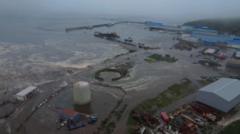A significant earthquake measuring 8.8 on the Richter scale struck near Russia's Kamchatka Peninsula on Wednesday at approximately 11:25 AM local time (00:25 AM BST). This seismic event is among the strongest ever recorded and has led to immediate tsunami alerts across the Pacific region.
In response to the quake, millions of residents in Japan, Russia, and the U.S. West Coast have been ordered to evacuate, with additional warnings extending to countries including China, the Philippines, Indonesia, New Zealand, and as far away as Peru and Mexico.
Initial footage shows large waves inundating buildings in the town of Severo-Kurilsk, resulting in significant flooding at the port and in fish processing facilities, while vessels were displaced from their moorings. Russian officials reported damage to the power grid within the Sakhalin region.
Approximately 1.9 million people in Japan have been advised to find higher ground, with some seeking refuge atop buildings in Hokkaido. In Hawaii, concerns of waves reaching up to 10 feet were communicated, though Governor Josh Green indicated no significant wave impacts had yet occurred. Authorities expect it may take an additional two to three hours to determine when it is safe for coastal residents to return.
Scientific assessments regarding potential damage remain uncertain as tsunami waves continue to traverse the Pacific. Chris Goldfinger, a marine geology professor from Oregon State University, emphasized the unpredictability of the tsunami's impact, stating, "Each country, each port, and each coastline will experience a very site-specific response." The most affected areas are predicted to be located southeast of the earthquake's epicenter.
The timeframe for tsunami arrival indicates that waves are expected to reach regions of British Columbia and California by 12:20 AM local time (09:20 AM BST) and Nome, Alaska by 3:20 AM (12:20 PM BST). Helen Janiszewski, an assistant professor in geophysics at the University of Hawaii, explained that tsunami waves travel at speeds comparable to that of a jet airplane, giving a rough estimate of travel time based on distance.
The earthquake, considered relatively shallow at a depth of 19.3 km (12 miles), was initially recorded as a magnitude 8.0 before being revised upwards. This significant quake is now tied for the sixth most severe earthquake historically and falls in line with other notable seismic events, such as the 2010 Chilean earthquake and the 1906 Ecuadorian earthquake. In comparison, the devastating 2004 Indian Ocean earthquake registered between 9.2 and 9.3 magnitude, resulting in catastrophic losses.




















